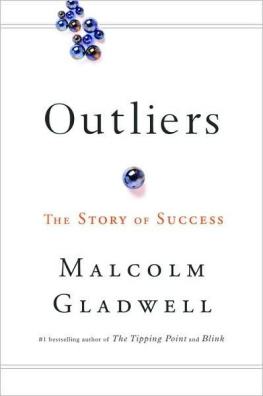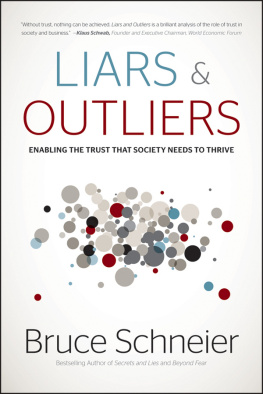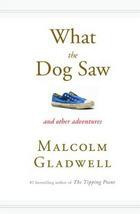Gladwell - Featured book review: Outliers: The Story of Success
Here you can read online Gladwell - Featured book review: Outliers: The Story of Success full text of the book (entire story) in english for free. Download pdf and epub, get meaning, cover and reviews about this ebook. City: Concordville;Pa;Norwood;Mass, year: 2010;2009, publisher: Soundview Executive Book Summaries, genre: Detective and thriller. Description of the work, (preface) as well as reviews are available. Best literature library LitArk.com created for fans of good reading and offers a wide selection of genres:
Romance novel
Science fiction
Adventure
Detective
Science
History
Home and family
Prose
Art
Politics
Computer
Non-fiction
Religion
Business
Children
Humor
Choose a favorite category and find really read worthwhile books. Enjoy immersion in the world of imagination, feel the emotions of the characters or learn something new for yourself, make an fascinating discovery.
- Book:Featured book review: Outliers: The Story of Success
- Author:
- Publisher:Soundview Executive Book Summaries
- Genre:
- Year:2010;2009
- City:Concordville;Pa;Norwood;Mass
- Rating:4 / 5
- Favourites:Add to favourites
- Your mark:
- 80
- 1
- 2
- 3
- 4
- 5
Featured book review: Outliers: The Story of Success: summary, description and annotation
We offer to read an annotation, description, summary or preface (depends on what the author of the book "Featured book review: Outliers: The Story of Success" wrote himself). If you haven't found the necessary information about the book — write in the comments, we will try to find it.
Featured book review: Outliers: The Story of Success — read online for free the complete book (whole text) full work
Below is the text of the book, divided by pages. System saving the place of the last page read, allows you to conveniently read the book "Featured book review: Outliers: The Story of Success" online for free, without having to search again every time where you left off. Put a bookmark, and you can go to the page where you finished reading at any time.
Font size:
Interval:
Bookmark:
Outliers, The Story of Success
THESE PEOPLE WERE DYING OF OLD AGE. THAT'S IT.
out-li-er \-,l(-9)r\ noun i: something that is situated away from or classed differently from a main or related body 2: a statistical observation that is markedly different in value from the others of the sample.
Roseto Valfortore lies one hundred miles southeast of Rome in the Apennine foothills of the Italian province of Foggia. In the style of medieval villages, the town is organized around a large central square. Facing the square is the Palazzo Marchesale, the palace of the Saggese family, once the great landowner of those parts. An archway to one side leads to a church, the Madonna del CarmineOur Lady of Mount Carmine. Narrow stone steps run up the hillside, flanked by closely clustered two-story stone houses with red-tile roofs.
For centuries, the paesani of Roseto worked in the marble quarries in the surrounding hills, or cultivated the fields in the terraced valley below, walking four and five miles down the mountain in the morning and then making the long journey back up the hill at night. Life was hard. The townsfolk were barely literate and desperately poor and without much hope for economic betterment until word reached Roseto at the end of the nineteenth century of the land of opportunity across the ocean.
In January of 1882, a group of eleven Rosetansten men and one boyset sail for New York. They spent their first night in America sleeping on the floor of a tavern on Mulberry Street, in Manhattan's Little Italy. Then they ventured west, eventually finding jobs in a slate quarry ninety miles west of the city near the town of Bangor, Pennsylvania. The following year, fifteen Rosetans left Italy for America, and several members of that group ended up in Bangor as well, joining their compatriots in the slate quarry. Those immigrants, in turn, sent word back to Roseto about the promise of the New World, and soon one group of Rosetans after another packed their bags and headed for Pennsylvania, until the initial stream of immigrants became a flood. In 1894 alone, some twelve hundred Rosetans applied for passports to America, leaving entire streets of their old village abandoned.
The Rosetans began buying land on a rocky hillside connected to Bangor by a steep, rutted wagon path. They built closely clustered two-story stone houses with slate roofs on narrow streets running up and down the hillside. They built a church and called it Our Lady of Mount Carmel and named the main street, on which it stood, Gari
baldi Avenue, after the great hero of Italian unification. In the beginning, they called their town New Italy. But they soon changed it to Roseto, which seemed only appropriate given that almost all of them had come from the same village in Italy.
In 1896, a dynamic young priest by the name of Father Pasquale de Nisco took over at Our Lady of Mount Carmel. De Nisco set up spiritual societies and organized festivals. He encouraged the townsfolk to clear the land and plant onions, beans, potatoes, melons, and fruit trees in the long backyards behind their houses. He gave out seeds and bulbs. The town came to life. The Rosetans began raising pigs in their backyards and growing grapes for homemade wine. Schools, a park, a convent, and a cemetery were built. Small shops and bakeries and restaurants and bars opened along Garibaldi Avenue. More than a dozen factories sprang up making blouses for the garment trade. Neighboring Bangor was largely Welsh and English, and the next town over was overwhelmingly German, which meantgiven the fractious relationships between the English and Germans and Italians in those yearsthat Roseto stayed strictly for Rosetans. If you had wandered up and down the streets of Roseto in Pennsylvania in the first few decades after 1900, you would have heard only Italian, and not just any Italian but the precise southern Foggian dialect spoken back in the Italian Roseto. Roseto, Pennsylvania, was its own tiny, selfsufficient worldall but unknown by the society around itand it might well have remained so but for a man named Stewart Wolf.
Wolf was a physician. He studied digestion and the stomach and taught in the medical school at the University of Oklahoma. He spent his summers on a farm in Pennsylvania, not far from Roseto although that, of course, didn't mean much, since Roseto was so much in its own world that it was possible to live in the next town and never know much about it. One of the times when we were up there for the summerthis would have been in the late nineteen fifties I was invited to give a talk at the local medical society, Wolf said years later in an interview. After the talk was over, one of the local doctors invited me to have a beer. And while we were having a drink, he said, 'You know, I've been practicing for seventeen years. I get patients from all over, and I rarely find anyone from Roseto under the age of sixty-five with heart disease.'
Wolf was taken aback. This was the 1950s, years before the advent of cholesterol-lowering drugs and aggressive measures to prevent heart disease. Heart attacks were an epidemic in the United States. They were the leading cause of death in men under the age of sixty-five. It was impossible to be a doctor, common sense said, and not see heart disease.
Wolf decided to investigate. He enlisted the support of some of his students and colleagues from Oklahoma. They gathered together the death certificates from residents of the town, going back as many years as they could. They analyzed physicians' records. They took medical histories and constructed family genealogies. We got busy, Wolf said. W e decided to do a preliminary study. We started in nineteen sixty-one. The mayor said, 'All my sisters are going to help you/ He had four sisters. He said, 'You can have the town council room/ I said, 'Where are you going to have council meetings?' He said, 'Well, we'll postpone them for a while/ The ladies would bring us lunch. We had little booths where we could take blood, do EKGs. We were there for four weeks. Then I talked with the authorities. They gave us the school for the summer. We invited the entire population of Roseto to be tested.
The results were astonishing. In Roseto, virtually no one under fifty-five had died of a heart attack or showed any signs of heart disease. For men over sixty-five, the death rate from heart disease in Roseto was roughly half that of the United States as a whole. The death rate from all causes in Roseto, in fact, was 30 to 35 percent lower than expected.
Wolf brought in a friend of his, a sociologist from Oklahoma named John Bruhn, to help him. I hired medical students and sociology grad students as interviewers, and in Roseto we went house to house and talked to every person aged twenty-one and over, Bruhn remembers. This happened more than fifty years ago, but Bruhn still had a sense of amazement in his voice as he described what they found. There was no suicide, no alcoholism, no drug addiction, and very little crime. They didn't have anyone on welfare. Then we looked at peptic ulcers. They didn't have any of those either. These people were dying of old age. That's it.
Wolf's profession had a name for a place like Rosetoa place that lay outside everyday experience, where the normal rules did not apply. Roseto was an outlier.
Wolf's first thought was that the Rosetans must have held on to some dietary practices from the Old World that left them healthier than other Americans. But he quickly real ized that wasn't true. The Rosetans were cooking with lard instead of with the much healthier olive oil they had used back in Italy. Pizza in Italy was a thin crust with salt, oil, and perhaps some tomatoes, anchovies, or onions. Pizza in Pennsylvania was bread dough plus sausage, pepperoni, salami, ham, and sometimes eggs. Sweets such as biscotti and taralli used to be reserved for Christmas and Easter; in Roseto they were eaten year-round. When Wolf had dieticians analyze the typical Rosetan's eating habits, they found that a whopping 41 percent of their calories came from fat. Nor was this a town where people got up at dawn to do yoga and run a brisk six miles. The Pennsylvanian Rosetans smoked heavily and many were struggling with obesity.
Font size:
Interval:
Bookmark:
Similar books «Featured book review: Outliers: The Story of Success»
Look at similar books to Featured book review: Outliers: The Story of Success. We have selected literature similar in name and meaning in the hope of providing readers with more options to find new, interesting, not yet read works.
Discussion, reviews of the book Featured book review: Outliers: The Story of Success and just readers' own opinions. Leave your comments, write what you think about the work, its meaning or the main characters. Specify what exactly you liked and what you didn't like, and why you think so.












